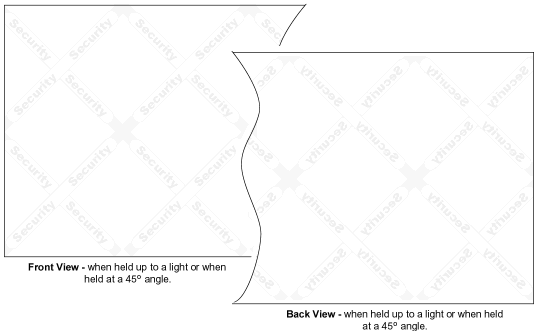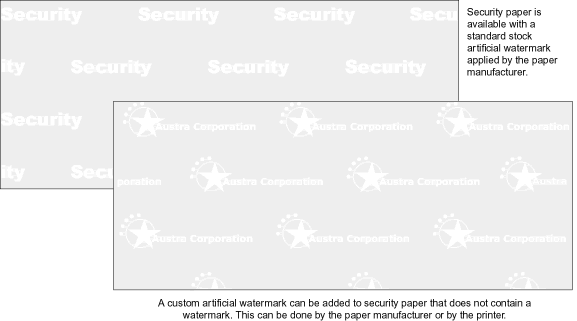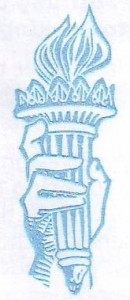Forgery of documents is becoming easier than ever before with the advancement being made in the technology of computers, scanners, printers and copiers. The problem does not only exist with check forgery but also with other documents that have dollar value or data value associated with them. The examples below give you an idea of some security problems that can occur on different documents.

Checks
Checks can be forged in several ways. Because of the advancement of technology in computers, scanners, printers and copiers, checks that do not have the proper security features, can be duplicated so that it is hard to tell the difference between the duplicated check and the original.
Another type of forgery that occurs on checks is the alteration of the dollar amount or the name of the payee on the check. This alteration is accomplished by a couple of different methods. If the check is printed through a printer, the image can be scraped off or lifted with tape and replaced with new information. The use of chemical solvents is another method which washes the ink from the check and then the amount is altered or the payee name is changed. It is important to incorporate security features in checks because the customer is held responsible for losses incurred from the forged checks unless they can show “due diligence”. “Due diligence” means that they must show that they have taken proper precaution on their part to protect their checks. This includes everything from incorporating proper security features to proper storage of checks.

Gift Certificates
Gift certificates can be altered in much the same way in which checks are altered. They may be duplicated or they can have the name and dollar amounts altered. This could result in a huge loss to a company if not detected soon enough.
Academic Transcripts
Transcripts have been altered by students to show higher grades than what were actually earned. Students alter their transcripts to affect their eligibility into another school or to mislead a prospective employer when being considered for employment.
Event Tickets/Passes
Scalpers will duplicate passes or tickets to events and then sell them for a profit. Not only is this a type of counterfeiting and illegal, it also can cause huge problems when large groups of people come to an event and find their seats have already been sold to another person.
Coupons
Without proper security features, coupons could be easily duplicated by using the technology of the computers and output devices that are available today. A restaurant owner may distribute a “Free Dinner” coupon to promote the opening of a new restaurant. If the coupon is illegally duplicated and distributed to more people than originally intended, the owner may incur substantial losses. Consumer coupon fraud is a big concern that needs to be dealt with but along with consumer fraud is retail fraud. Retail coupon fraud occurs when non-legitimate retailers add in coupons that have not actually been received through a consumer’s purchase. One way additional coupons are obtained is through fraudulent duplication of the original coupons. The counterfeit coupons are sent in with the actual consumer coupons to the manufacturer for redemption. Any business, from a private restaurant to a large company, could loose a substantial amount from fraudulent coupons.
True Watermarks | Artificial Watermarks
Watermarks can be used on documents to provide an effective form of protection against counterfeiting. The watermark images are invisible or difficult to view unless held up to the light or held at a 45° angle. They can be applied as a true watermark which is applied to the paper during the manufacturing process or as an artificial watermark which is applied by a printing process. Either type of watermark provides a security feature that is difficult, if not impossible, to copy by copiers and scanners. Shown below is a description of a true watermark and an artificial watermarks.
True Watermarks
True watermarks are made during the paper manufacturing process. An image is formed when different degrees of pressure are applied to the paper by a dandy roll, containing the image, while the paper is still wet. True watermarks are also referred to as fourdrinier watermarks. Security paper with this feature is distributed only to authorized manufactures, making it difficult for counterfeiters to obtain.

| A true watermark is visible from the front and the back of the paper when viewed in regular light. The image of a true watermark cannot be copied or scanned to produce the same effect. The inability to be copied or scanned provides, to your document, a high level of security against counterfeiting |
| True watermarks are most often a standard watermark applied by the paper manufacturer but can be applied as a custom application. A custom watermark will add extra security to your document by making it next to impossible for the counterfeiter to obtain your special watermarked paper. There are a few things to keep in mind when considering the use of a custom watermark. A dandy roll must be special ordered with the custom image that is to be applied. The cost of the custom dandy roll can add a substantial amount to the initial cost of the paper but is usually a one time charge as long as the image does not change. The cost per hundred weight of the paper may also be affected. There are generally additional setup charges from the mill, minimum order requirements, and extended lead times on delivery of the paper. These issues need to be considered when determining the value of a custom watermark. |
Artificial Watermarks
Artificial watermarks are applied after the paper manufacturing process. They can be applied by the paper manufacturer or by the printer. Many paper manufacturers offer stock security papers that have a standard artificial watermark applied to them. The cost of the security paper with an artificial watermark is generally a little less expensive than one with a true watermark.
| An artificial watermark can be seen from one side only. It is generally applied to the back side but can be applied to the front side also. The watermark is achieved by printing the image in opaque white ink, transparent ink or by using varnish. They will all produce an image that is visible when viewed at an angle. An artificial watermark is sometimes also referred to as ghost printing. Artificial watermarks are nearly impossible to duplicate by copier or scanners, making this a good security feature to add to your documents. Adding a customized artificial watermark to your document will make it even more difficult to duplicate. Customizing an artificial watermark is less expensive than customizing a true watermark. The customizing can be accomplished by the paper manufacturer or the printer. The most cost effective alternative will depend on the quantity of watermarked paper needed. Consult your supplier as to what would be the best alternative for your needs. |
| |

Security Features | Special Print Processes
Hot Stamp Foil Printing

The hot stamp foil printing process bonds foil to paper or plastic to create a special foil image. The bonding of the foil to paper or plastic is created by using a metal die, heat and pressure. Using foil printing is a very effective way to add security to your document. It cannot be duplicated by scanners or copiers. Hot stamp foil printing makes an effective deterrent to forgers since they would have to use the actual foil stamping process to reproduce the document with the foil image. Foil printing can be applied in single color, multiple color, rainbow color or with a holographic pattern.
Prismatic Printing
Prismatic printing is a special printing technique where a pantograph background is printed in two or more colors on the same printing unit. The different ink colors merge where they meet in the ink fountain to form a blend of colors in the background. The special varying effect is very difficult to reproduce by using a scanner, computer or copier.

Intaglio Printing
The intaglio printing process uses a metal plate that has had the image cut into the surface. The sunken image is filled with ink and the surface is wiped clean so only ink is left in the sunken image areas. Then dampened paper comes in contact with the plate and pressure is applied, embossing the image and forcing the ink in the image areas to transfer to the paper. The embossed ridges can be felt when rubbing across the surface, indicating the the document is an original. The intaglio printing process is used on old US currency and 95% of the world’s currency. It is also used on stocks, bonds and other valuable documents. It is a very specialized process that gives a document a very high quality look. This high quality printing cannot be reproduced by using scanners, color copiers or computers with laser printers. Intaglio is an old printing process but is still used today as one of the best security features on valuable documents.
Security Using an Intaglio Press
Close-up of an engraved image
Secure Far Beyond Offset or Digitized Printing
In a world where photocopy machines, scanners, and computers can reproduce two-dimensional images within seconds, a raised intaglio image adds tactile, undigitizable protection to documents.
More importantly, the pressure generated in the intaglio impression forces the ink into the fibers of the paper. The image is not only tactile as an overt security check, but once dry, the ink will be embedded in the paper.
Cronite’s Equipment and Inks – An Unbeatable System
Cronite flat stamping intaglio presses are the most cost effective way to produce an intaglio image. In addition to being vastly less expensive than a rotary intaglio system, Cronite presses are extremely versatile.
Cronite Presses Can:
Engraved images are tactile
- Print latent images
- Print micro text
- Print guilloches
- Print multi-color intaglio images
- Print a raised image with more height than traditional rotary machinery can produce
- Blind emboss
- Hot foil stamp
- With an additional part, attach registered holograms
Combine Layers of Protection
As with any security printing operation, many layers of both overt and covert protection are added to make a document harder to reproduce. Another layer of protection is gained by using security inks. Cronite produces a wide range of inks which can be used in security operations. Please see our Security Ink page for a partial listing

